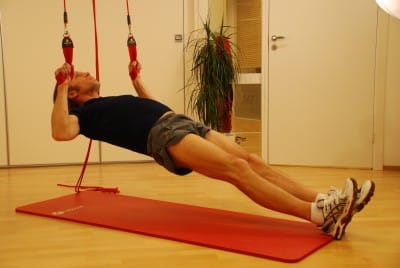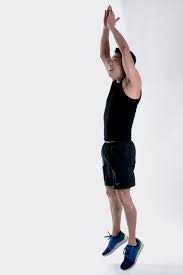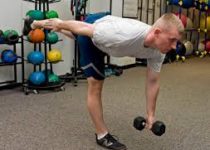Bodyweight HIIT Workout - How To Create It Yourself!
For a reason, HIIT is currently one of the most popular forms of cardio amongst both professionals & beginners. Some of the most obvious advantages over other forms of cardio being its short time under tension & efficiency.
In this article, I will explain to you how to create HIIT workouts yourself & you will also find a full routine in the end!
But before diving into the workouts it's important to define HIIT once again, as I've met many people being confused about what belongs to HIIT and what doesn't!
If you are 100% certain that you know & understand what HIIT is, you can skip the definition below.
Definition HIIT
HIIT stands for High-Intensity Interval Training, which means it is a form of training where you perform exercises at high intensities!
To clarify what high intensity means, you have to consider that the exercises must be difficult to do for more than 10-15seconds. Anything above 30seconds of time under tension or above 15 repetitions has nothing to do with HIIT.
Besides that, it is a form of interval training, which means you are going to have times of being under tension & times of rest, which can vary depending on your goals.
Still, breaks should be kept below 2 minutes when doing HIIT training. Since the intensity is quite high, while there isn't too much rest in between each set your workouts should never be longer than 1 hour.
In most cases, training for 15-30minutes (excluding warm-up & cool down) is going to be more than enough!
Now that we've cleared up some of the misconceptions that people frequently have we can get into the process of making a workout!
How To Create A HIIT Routine
In case you aren't interested in the theory of creating HIIT routines & workouts, you can jump straight to the 20-minute full-body HIIT workout below.
What Does A HIIT Workout Consist Of?
- Exercises
- Periods of Time under Tension
- Periods of Rest
- Sets
Basically these 4 parts are all the building blocks that you need to create a HIIT training routine. So let's break each component down, so that you understand how to use them.
Exercises:
Depending on what muscle groups you want to train but also how fast you want to be done with your workouts the exercises play a crucial rule. As a basic rule, a workout with very specific & isolating exercises will need a broader range of exercises.
On the other hand, if you use functional exercises such as Burpees, Squats, Push-ups which most bodyweight exercises are it is going to be easier to train your entire body with just a few exercises!
Another advantage of doing bodyweight exercises is that you will automatically train your core as exercises such as push-ups, pull-ups are quite challenging for your abs when performed the right way.
So if you're creating any type of routine it works best to categorize different exercises either by muscle groups or by movement type.
Since bodyweight exercises work for multiple muscle groups at a time it makes more sense to work with these 4 categories.

Push
A pushing exercise can be a push-up or triceps dip but also doing benchpresses and all other exercises where you engage muscles around your triceps, shoulders & chest.
Pull
As the name suggests some of the most common pulling exercises are pull-ups, Australian pull-ups & cable pull-downs. The muscle groups trained are primarily your shoulders, biceps & latissimus.
Just by combining push & pull exercises you've already gotten the entire upper body including your abs covered.


Core & Lower Back
But if you feel like the static engagement that comes with Push & Pull exercises isn't enough you can add core & lower back exercises.
Lower Body
Last but not least it is important to include leg & glute exercises in your body workouts. Squats, Lunges, Pistol squats & Plyometrics are the best options when doing bodyweight training.

Periods Of Time Under Tension
Time under tension simply stands for the time that you are doing one specific exercise. While a lot of people like sticking with repetitions as a guideline time under tension is the better alternative.
Why?
Imagine two people doing push-ups; one person is doing the negative part of the motion slowly (3sec) and goes up very fast (1sec). In order to do 10 Push-ups, he would need 40 seconds.
Another person does the negative part of the motion quite fast and only takes 1 second to go down and 1 second to go up. He would only take 20 seconds to do 10 push-ups.
Person 1, has clearly done more since time under tension is the more accurate factor in this scenario!
How Much Time Under Tension?
Since you are training at very high intensities, you shouldn't do any of the exercises for more than 20 seconds. Rather try to stay between 10-15seconds.
Periods Of Rest
Rest is quite easy to understand, it simply is the time where you do nothing & relaxes between the sets.
How Long?
It depends a little bit on your focus;
If you want to focus on fat burning & do total body home workouts, you should try to rest for less than 45 seconds.
On the other hand, if you want to create separate days for Push/Pull/Lower Body and your focus is on muscle growth & explosive strength you should rest between 1-2 min between the exercises.
Sets
Once you've figured out the exercises, time under tension & length of resting periods, you only need to know how many sets you are going to do of each exercise.
Depending on how many exercises you've chosen the number of sets is going to change. Since a HIIT workout should take less than 30 minutes (excluding warm-up & cooldown!!!) you won't need more than 3 sets of each exercise. In most cases, it makes sense to do between 2-3 sets of each exercise.
Regarding sets you can also decide between doing a circuit; Do one set of each exercise and then repeat the circuit; Alternatively, you can also complete 2-3 sets of exercise 1 and work yourself through the exercises that you took.
But there is one more factor that comes into play if you are planning to work out more than once a week.
You need to decide between
Full Body Training VS Training Particular Muscle Groups
In general, when training for muscle growth it makes more sense to focus on particular muscle groups on specific days.
On the other hand, if you want to do HIIT cardio to burn body fat it makes more sense to stick with full-body routines.
Especially if you're already doing strength training on a regular basis there is no need to isolate muscle groups during HIIT sessions.
The 15 Minute Full-Body Bodyweight Workout
This is a sample full-body HIIT workout routine, which you can follow. Furthermore, I will explain how to adjust the difficulty to your own level! All the exercises are bodyweight exercises and can be done anywhere!
- Burpees 15sec
- Rest 45sec
- Push-ups 15sec
- Rest 45 sec
- Australian Pull-ups 15 sec
- Rest 45 sec
- Sprint 15sec
- Rest 45 sec
- Jackknifes 15sec
- Rest 45 sec
Repeat The Workout 2-3 Times!



Jackknifes

Notes:
- For Australian Pull-ups, you can place a broomstick across two chairs to do the exercise
- If you train inside instead of sprinting you can do Mountain Climbers!
How To Adjust The Difficulty
If the workout is too hard or easy for you, there is the option to adjust the difficulty. You have 5 options to increase or decrease the difficulty.
Change the difficulty of the exercises
Even with bodyweight exercises, it is surprisingly easy to make the exercise harder or easier. Do the push-ups with your hands on an elevated surface to make it easier, or get your feet higher up to make them harder. To make the Australian pull-ups easier, you can do them with bend legs; to make them harder you can find a box/chair to elevate your feet.
If Jackknives is too hard for you, feel free to do sit-ups or another exercise instead!
Change the time under tension
To make the workout harder & also turn it even more into cardio you can do 20seconds of time under tension instead. Although it then starts to drift away from what HIIT is all about! (short time under tension)
But doing 10 seconds of the exercises instead is totally fine to make the workout slightly easier.
Change the resting periods
Also, you can rest 5-10 sec longer or less to change the difficulty of the workout.
Repeat it more/less often
If doing the circuit twice feels too easy, you might want to consider doing it 3x instead!
Conclusion
If you have any questions regarding creating your own workouts feel free to leave a comment! Share this article with your friends if they might find it helpful!
Also, leave a comment below if you want to know more about creating your own workouts!


